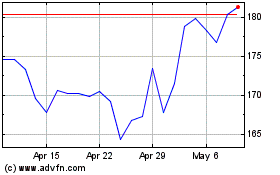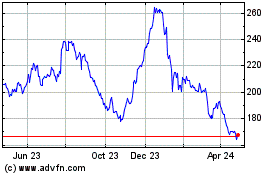NASA Looks to Reserve More Seats on Russian Spacecraft for U.S. Astronauts
January 18 2017 - 11:04PM
Dow Jones News
By Andy Pasztor
NASA has formally acknowledged what many aerospace industry
officials have speculated for years: U.S.-built spacecraft won't be
ready to routinely transport American astronauts into orbit by 2018
as promised.
In a contracting document released Tuesday, the National
Aeronautics and Space Administration said it is considering
securing up to five additional seats for American astronauts in
Russian capsules over the next three years. The move is necessary,
according to the agency, partly because U.S. commercial providers
aren't expected to begin fully operational flights to the
international space station until 2019.
Initially the deadline for the flights was 2015. Boeing Co. and
Elon Musk's Space Exploration Technologies Corp. have promised to
start ferrying astronauts to the international orbiting laboratory
by 2018 at the latest. At this point, NASA has secured Russian
seats through the end of that year.
NASA's latest document goes further than the agency has before
in conceding the starting date for operational flights may continue
to slip. Three additional seats that may be purchased for spring
2019 missions would provide "primary or backup transportation
capability," according to the agency.
In an unusual twist, the seats would be purchased from Boeing,
which acquired them as part of a settlement with Russian space
authorities in an unrelated legal dispute.
But signals that NASA is moving toward extending its reliance on
Russian rockets and capsules is bound to cause consternation and
prompt criticism on Capitol Hill. The price Russia charges for a
single seat has averaged $81 million, but that could rise.
Still, there is no other way for NASA to get its astronauts into
orbit, or fly them back to Earth, since the agency retired its
space-shuttle fleet six years ago.
While the U.S. increases its seats in the Russian capsules,
Moscow is reducing the number of its astronauts slated to be on the
space station in coming years. Cutting its permanent crew
complement to two from the typical three suggests support for the
space station is waning among Russian authorities. NASA, by
contrast, hopes to pick up some of those slots as part of its
campaign to step up scientific activity onboard the station.
Technical problems encountered by the two American companies
have been well publicized over the years, ranging from leaking
capsules to propulsion issues. NASA's document noted that without
assured transportation for U.S. crews to the station, the orbiting
laboratory could stop functioning.
Despite the pressure, senior managers at both companies have
stressed they won't fly manned capsules until all safety issues are
resolved.
NASA's announcement doesn't commit the agency to procuring the
extra seats, but it does reserve that option for President-elect
Donald Trump's administration . Historically, Russian officials
have demanded a three-year lead time for providing seats to
NASA.
Last week, NASA's safety watchdogs issued a report indicating
that some technical issues remain challenging and of concern.
Whether the necessary work to mitigate or eliminate those hazards
"can be accomplished without a substantial slip in the schedule
remains to be seen," according to the advisory board's report.
Write to Andy Pasztor at andy.pasztor@wsj.com
(END) Dow Jones Newswires
January 18, 2017 22:49 ET (03:49 GMT)
Copyright (c) 2017 Dow Jones & Company, Inc.
Boeing (NYSE:BA)
Historical Stock Chart
From Mar 2024 to Apr 2024

Boeing (NYSE:BA)
Historical Stock Chart
From Apr 2023 to Apr 2024
